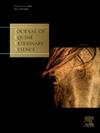Sedation with xylazine and detomidine for andrological examination in horses and reversal with yohimbine: is there an impact on ejaculate quality?
IF 1.3
3区 农林科学
Q2 VETERINARY SCIENCES
引用次数: 0
Abstract
For transrectal palpation and ultrasonography to assess the internal glands of a stallion, veterinarians often use physical or chemical restraint to facilitate the procedure, with the majority using sedation (Pearson et al., Equine Veterinary Education, 2020; 33: 522-530). The objectives of the study were to evaluate the use of a combination of xylazine and detomidine sedation (SEDACOMBOⓇ: 0.4 mg/kg of xylazine and 0.008 mg/kg of detomidine, Botupharma Ltda., Botucatu, SP, Brazil) to perform an internal reproductive system examination, as well as the reversal by yohimbine (RESETⓇ: 0.1 mg/kg, Botupharma Ltda., Botucatu, SP, Brazil) on the sperm parameters of stallions. Five stallions, aged 4 to 20 years, were assigned to 3 different treatments in a crossover design: CONTROL (saline solution/saline solution), GROUP 1 (SEDACOMBOⓇ/RESETⓇ), and GROUP 2 (saline solution/RESETⓇ). After stimulation by an estrous mare, an intravenous injection of SedacomboⓇ or saline solution was given. After 30 minutes, RESETⓇ or saline solution was administered, and after an additional 15 minutes, semen collection was performed. Immediately after collection, the ejaculate was analyzed for volume (with and without gel), total number of sperm, sperm concentration, sperm kinetics (Computer Assisted Sperm Analyses - CASA), membrane stability, mitochondrial potential, and superoxide anion generation via flow cytometry. Statistical analysis was performed using the Kolmogorov-Smirnov, ANOVA, and Tukey tests, with P<0.05 considered significant. GROUP 2 showed a higher seminal volume, with gel (103.7±12.2 ml) and without gel (87.4±8.4 ml), compared to the CONTROL group (62.2±9.9 and 51.8±8.3 ml; P<0.05) and without gel compared to GROUP 1 (P<0.05) (53.6±8.0 ml). Sperm concentration was lower in GROUP 2 (P〈 0.05) (97.8±11.1 × 106/ml) compared to CONTROL (185.3±27.2 × 106/ml), but similar to GROUP 1 (167.8±33.7 × 106/ml). The total sperm number remained the same across all treatments. GROUP 1 demonstrated greater membrane stability (84±1.5%) compared to GROUP 2 (72.0±4.4%). The CONTROL group (83.2±2.5%) and GROUP 1 (84.4±1.1%) had similar numbers of cells with high mitochondrial potential, both more than GROUP 2 (73.6±4.1%). Other parameters (kinetics and superoxide anion generation) did not differ between groups. The increase in ejaculate volume in GROUP 2 can be explained by the presence of yohimbine, which blocks alpha-2 adrenergic receptors in the central nervous system, stimulating the ejaculation process (Yonezawa et al., Biomedical Research, 2005; 26: 201-206). The increase in seminal plasma in GROUP 2 explains the decrease in sperm membrane quality (Monteiro et al., Veterinária e Zootecnia, 2011; 18(2): 255-263). In conclusion, the isolated application of RESETⓇ altered sperm membrane integrity, but when applied 30 minutes after sedation with SEDACOMBOⓇ, no variations in sperm parameters were observed, making it a viable alternative treatment during andrological examination.
求助全文
约1分钟内获得全文
求助全文
来源期刊

Journal of Equine Veterinary Science
农林科学-兽医学
CiteScore
2.70
自引率
7.70%
发文量
249
审稿时长
77 days
期刊介绍:
Journal of Equine Veterinary Science (JEVS) is an international publication designed for the practicing equine veterinarian, equine researcher, and other equine health care specialist. Published monthly, each issue of JEVS includes original research, reviews, case reports, short communications, and clinical techniques from leaders in the equine veterinary field, covering such topics as laminitis, reproduction, infectious disease, parasitology, behavior, podology, internal medicine, surgery and nutrition.
 求助内容:
求助内容: 应助结果提醒方式:
应助结果提醒方式:


